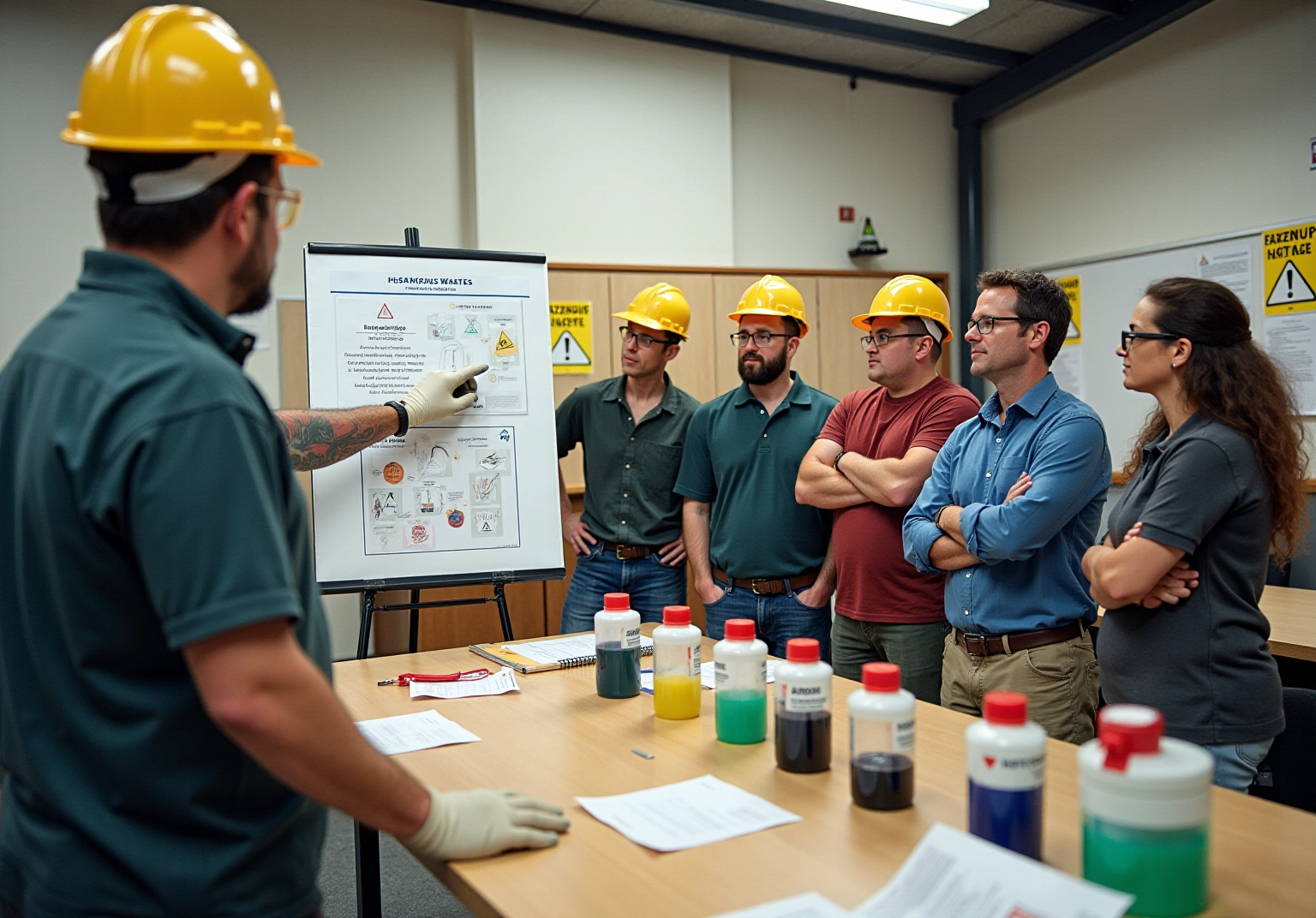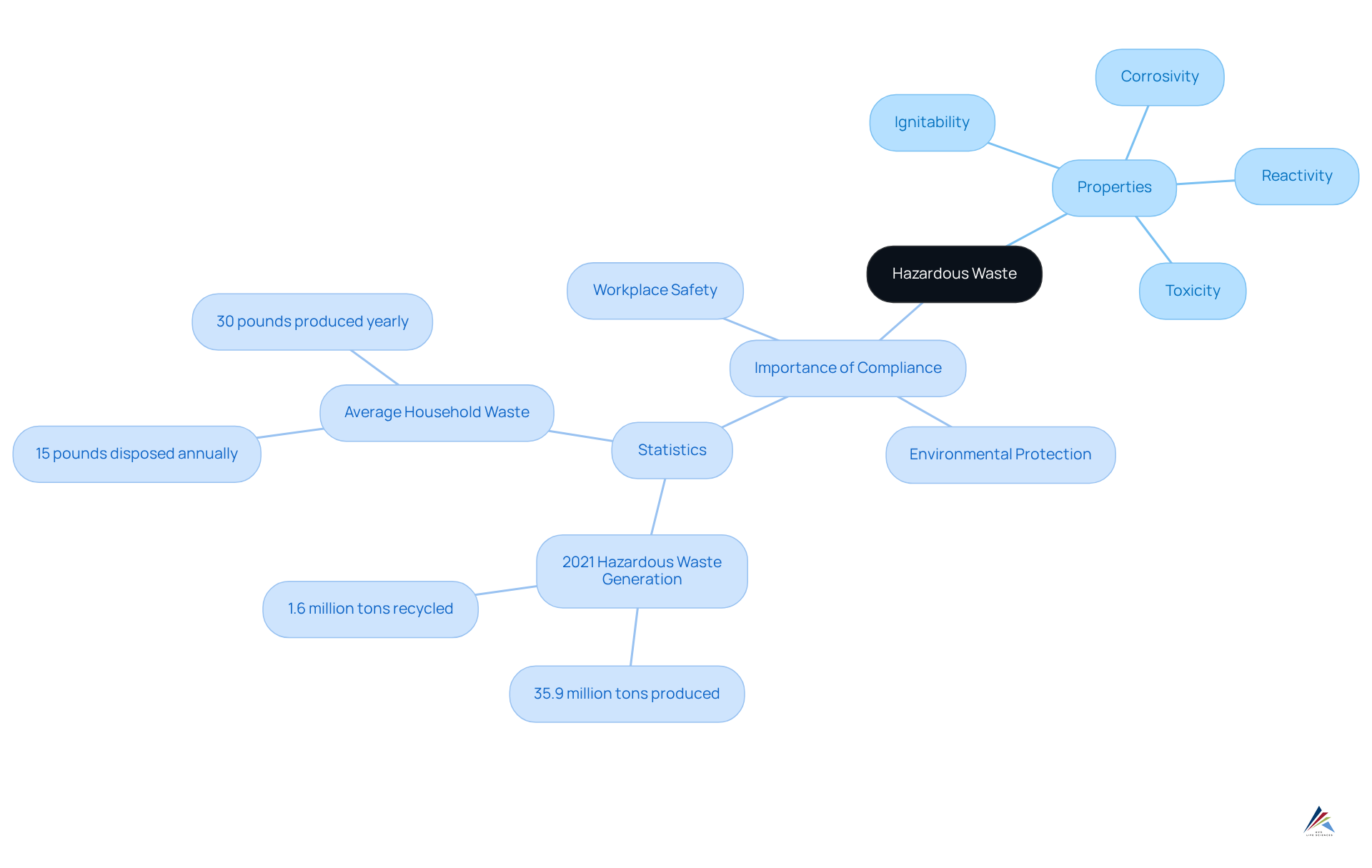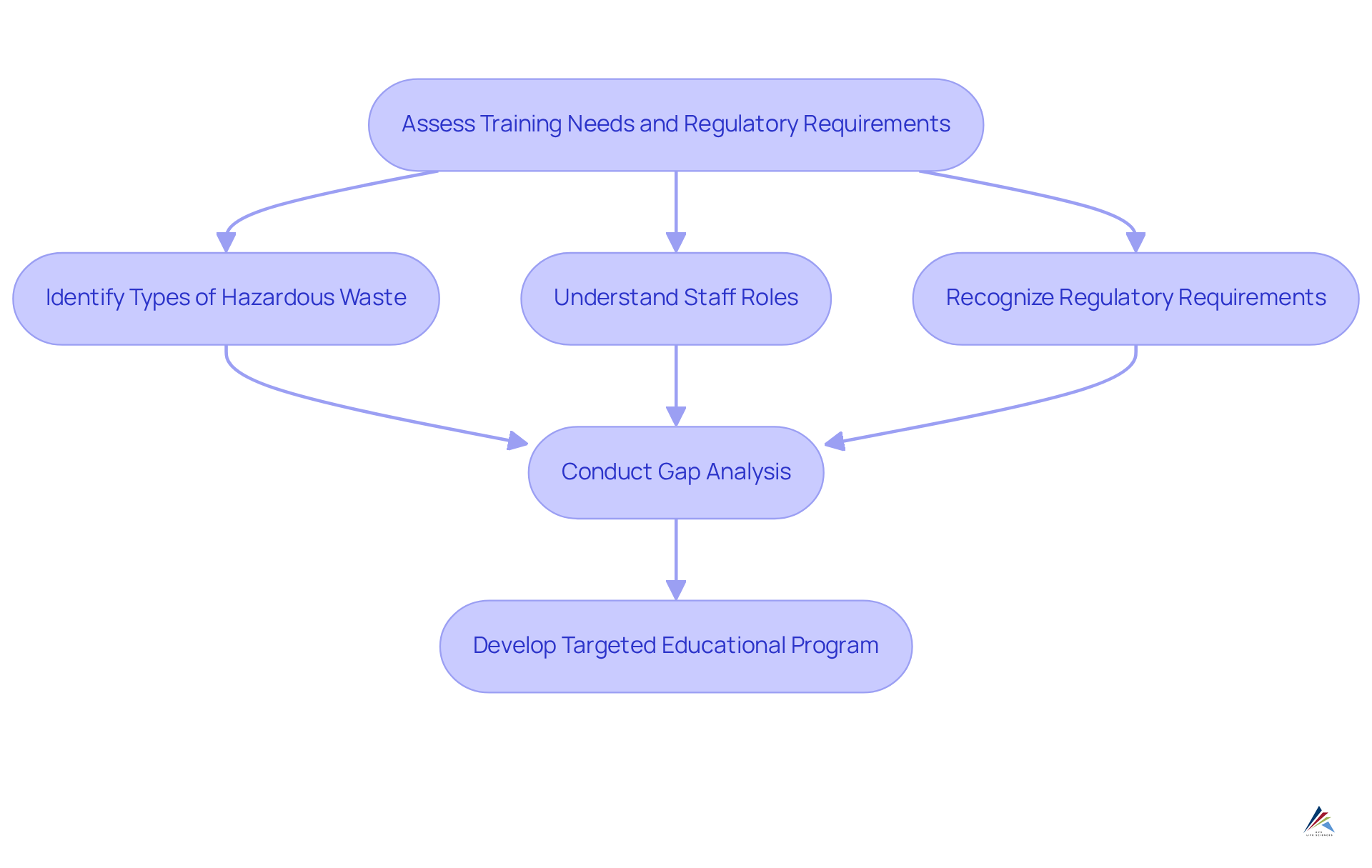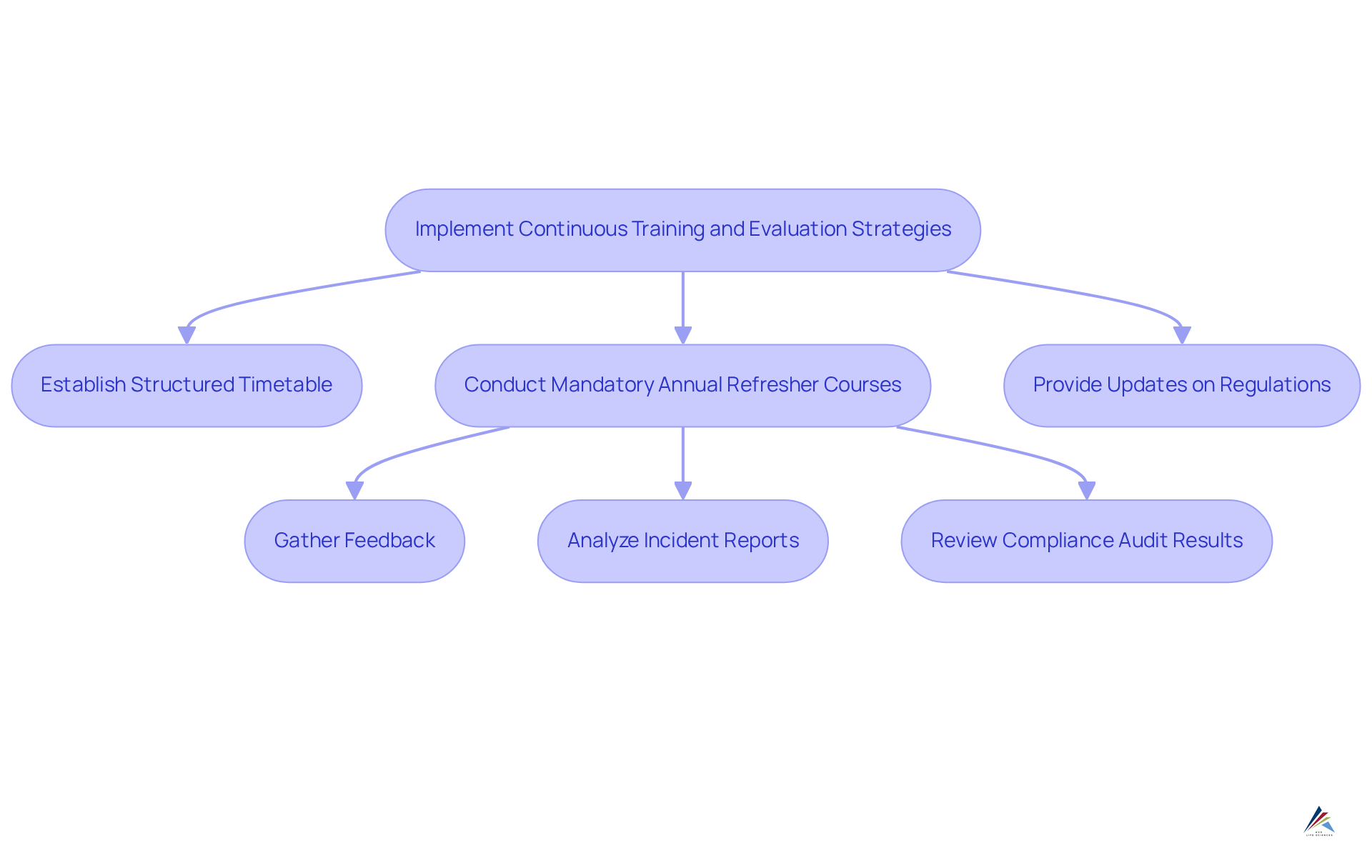4 Steps for Effective Hazardous Waste Training Compliance

Overview
The article delineates four crucial steps for achieving effective compliance in hazardous waste training:
- Defining hazardous waste
- Assessing training needs
- Developing a comprehensive program
- Implementing continuous training strategies
These steps underscore the necessity of understanding hazardous materials and regulatory requirements, ensuring that employees are adequately trained to manage these substances safely and in accordance with legal standards. This approach not only safeguards public health but also protects the environment, reinforcing the imperative for organizations to prioritize compliance in their operational strategies.
Introduction
Understanding hazardous waste is not merely a regulatory requirement; it stands as a vital component of workplace safety and environmental protection. With millions of tons of hazardous materials generated annually, organizations encounter the urgent challenge of ensuring their employees receive comprehensive training to handle these substances safely. This article explores the essential steps for developing an effective hazardous waste training program, emphasizing the significance of compliance and the potential risks associated with inadequate training.
How can organizations effectively balance the demands of regulatory compliance while cultivating a culture of safety in hazardous waste management?
Define Hazardous Waste and Its Importance in Compliance
Hazardous materials encompass substances that pose significant or potential risks to public health and the environment. These materials can be categorized based on specific properties, such as:
- Ignitability
- Corrosivity
- Reactivity
- Toxicity
Understanding these characteristics is critical for complying with regulations like the (RCRA), which governs the management of hazardous materials from generation to disposal. Compliance is not merely a legal obligation; it is vital for ensuring workplace safety and protecting the environment.
For instance, in 2021, large quantity generators produced approximately 35.9 million tons of hazardous materials in the U.S., marking a notable increase from previous years. However, only 1.6 million tons were recycled, underscoring the urgent need for effective management practices. Moreover, the average U.S. household disposes of about 15 pounds of hazardous materials in their trash each year, highlighting the prevalence of harmful substances and the importance of proper management.
Organizations must guarantee that employees receive adequate hazardous waste training to properly identify and handle hazardous materials, as improper management can lead to severe penalties and significant environmental harm. This foundational understanding is the first step in developing a robust program for managing hazardous materials, ultimately contributing to a safer workplace and a healthier environment.

Assess Training Needs and Regulatory Requirements
To develop an efficient program for hazardous waste training, organizations must begin by thoroughly evaluating their specific educational requirements. This crucial process involves:
- Identifying the types of hazardous waste produced
- Understanding staff roles in managing this waste
- Recognizing the regulatory requirements that apply to the organization
Under the Resource Conservation and Recovery Act (RCRA), it is mandated that employees receive within six months of their hire date and complete annual refresher courses. For Large Quantity Generators (LQG), it is essential to provide specialized hazardous waste training within this timeframe.
Conducting a gap analysis is essential to pinpoint areas where current education may be insufficient. Furthermore, organizations should assess the unique challenges presented by their operations, including the types of dangerous materials handled and the associated risks. This comprehensive evaluation will guide the development of a targeted educational program that includes hazardous waste training and aligns with both regulatory standards and organizational objectives.
Notably, the United States generates nearly 400 million tons of hazardous waste each year, underscoring the necessity of effective programs for managing hazardous waste. The EPA reports a compliance rate exceeding 90% among regulated entities, highlighting the success of RCRA education in achieving compliance. According to regulatory bodies, 'any staff member who has RCRA-related duties has a RCRA educational requirement.' This thorough assessment will ensure that organizations are well-prepared to meet both regulatory and operational demands.

Develop a Comprehensive Training Program
A comprehensive hazardous waste training program must include several critical components to ensure employee safety and regulatory compliance.
- Identification of Dangerous Materials: Employees must be trained to recognize various types of dangerous materials and understand their properties. This foundational knowledge is crucial for effective resource management. In 2019, more than 34.9 million tons of dangerous materials were reported by Large Quantity Generators (LQGs) in the United States, underscoring the magnitude of the issue.
- Hazardous waste training should include proper handling and storage practices, emphasizing the use of appropriate personal protective equipment (PPE) and proper storage techniques to minimize risks. Mark Chocola, a prominent authority in dangerous material solutions, asserts that "safe and compliant management of toxic materials is crucial for safeguarding both employees and the environment."
- Emergency procedures necessitate that employees participate in hazardous waste training to be knowledgeable about emergency response protocols for spills or accidents involving dangerous materials, ensuring swift and effective action when incidents arise.
- Documentation and Recordkeeping: Maintaining precise records of dangerous material management activities—including generation, storage, and disposal—is vital for organizations to remain compliant with regulations. Non-compliance can lead to significant civil penalties, reaching up to $76,764 per day.
- necessitates that employees undergo hazardous waste training to ensure they are educated on relevant regulations and understand the potential consequences of non-compliance, thereby reinforcing the importance of adherence to legal standards.
- Assessment and Evaluation: Incorporating assessments, such as quizzes, practical demonstrations, and scenario-based exercises, allows organizations to evaluate staff comprehension and retention of the material. Specific instances of efficient dangerous materials identification instruction can further enhance the learning experience.
By focusing on these elements, organizations equip their staff with the essential skills and knowledge to manage dangerous materials securely and in compliance with regulatory standards.

Implement Continuous Training and Evaluation Strategies
Implementing ongoing development and assessment methods is crucial for upholding compliance and ensuring worker safety in hazardous materials management. Organizations must establish a structured timetable for regular development sessions, which should include mandatory annual refresher courses and updates on evolving regulations or procedures. For instance, OSHA mandates that all staff engaged in hazardous waste operations undergo a minimum of eight hours of hazardous waste training each year to maintain compliance, underscoring the vital importance of continuous education.
Regular assessments of the development program are essential for identifying areas that require enhancement. This can be accomplished by gathering feedback from employees, analyzing incident reports, and reviewing . Moreover, leveraging technology, such as Learning Management Systems (LMS), can facilitate the monitoring of development progress and ensure detailed record-keeping.
Fostering a culture of continuous learning not only enhances practices related to hazardous waste training but also guarantees ongoing adherence to regulatory requirements. Regular refresher courses, which are critical for keeping workers informed about the latest safety protocols, can significantly reduce the risk of accidents and improve emergency response capabilities. In fact, appropriate emergency response training can decrease fatalities by approximately 50%. By prioritizing these strategies, organizations can effectively navigate the complexities of hazardous waste management and uphold safety standards while ensuring compliance through hazardous waste training to avoid potential OSHA fines that can reach $14,502 per violation.

Conclusion
Understanding and implementing effective hazardous waste training compliance is essential for organizations aiming to protect public health and the environment. By clearly defining hazardous waste and recognizing its significance, organizations can establish a solid foundation for compliance that prioritizes safety and environmental stewardship. The importance of adequately training employees in hazardous waste management cannot be overstated; it directly impacts regulatory adherence and the overall safety of the workplace.
To achieve effective compliance, organizations must follow four critical steps:
- Defining hazardous waste
- Assessing training needs
- Developing a comprehensive training program
- Implementing continuous training and evaluation strategies
Each step underscores the necessity of understanding hazardous materials, regulatory requirements, and the ongoing commitment to training, ensuring employees are equipped to handle hazardous waste safely. The statistics presented highlight the urgency of these measures, as millions of tons of hazardous materials are generated annually, necessitating robust training programs to mitigate risks.
Ultimately, fostering a culture of continuous learning and compliance in hazardous waste management is vital for organizations. By prioritizing effective training strategies, organizations not only protect their employees and the environment but also avoid significant legal and financial repercussions. Investing in comprehensive hazardous waste training programs transcends regulatory obligation; it embodies a commitment to creating a safer and more sustainable future for all.
Frequently Asked Questions
What is hazardous waste?
Hazardous waste refers to substances that pose significant or potential risks to public health and the environment. These materials can be categorized based on properties such as ignitability, corrosivity, reactivity, and toxicity.
Why is understanding hazardous waste important?
Understanding hazardous waste is critical for complying with regulations like the Resource Conservation and Recovery Act (RCRA), which governs the management of hazardous materials from generation to disposal. Compliance ensures workplace safety and protects the environment.
What statistics highlight the issue of hazardous waste management in the U.S.?
In 2021, large quantity generators produced approximately 35.9 million tons of hazardous materials in the U.S., with only 1.6 million tons being recycled. Additionally, the average U.S. household disposes of about 15 pounds of hazardous materials in their trash each year.
What are the consequences of improper hazardous waste management?
Improper management of hazardous waste can lead to severe penalties and significant environmental harm, emphasizing the need for effective management practices.
What is the role of training in hazardous waste management?
Organizations must ensure that employees receive adequate hazardous waste training to properly identify and handle hazardous materials, which is essential for safe management and compliance with regulations.
